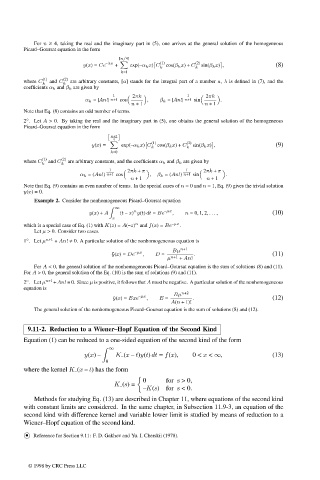Page 508 - Handbook Of Integral Equations
P. 508
For n ≥ 4, taking the real and the imaginary part in (5), one arrives at the general solution of the homogeneous
Picard–Goursat equation in the form
[n/4]
y(x)= Ce –λx + exp(–α k x) C (1) cos(β k x)+ C (2) sin(β k x) , (8)
k
k
k=1
where C k (1) and C (2) are arbitrary constants, [a] stands for the integral part of a number a, λ is defined in (7), and the
k
coefficients α k and β k are given by
1 2πk 1 2πk
α k = |An!| n+1 cos , β k = |An!| n+1 sin .
n +1 n +1
Note that Eq. (8) contains an odd number of terms.
2 . Let A > 0. By taking the real and the imaginary part in (5), one obtains the general solution of the homogeneous
◦
Picard–Goursat equation in the form
n+2
4
(1) (2)
y(x)= exp(–α k x) C cos(β k x)+ C sin(β k x) , (9)
k k
k=0
where C (1) and C (2) are arbitrary constants, and the coefficients α k and β k are given by
k k
1 2πk + π 1 2πk + π
α k =(An!) n+1 cos , β k =(An!) n+1 sin .
n +1 n +1
Note that Eq. (9) contains an even number of terms. In the special cases of n = 0 and n = 1, Eq. (9) gives the trivial solution
y(x) ≡ 0.
Example 2. Consider the nonhomogeneous Picard–Goursat equation
∞
n
y(x)+ A (t – x) y(t) dt = Be –µx , n =0, 1, 2, ... , (10)
x
n
which is a special case of Eq. (1) with K(z)= A(–z) and f(x)= Be –µx .
Let µ > 0. Consider two cases.
◦
1 . Let µ n+1 + An! ≠ 0. A particular solution of the nonhomogeneous equation is
Bµ n+1
¯ y(x)= De –µx , D = . (11)
µ n+1 + An!
For A < 0, the general solution of the nonhomogeneous Picard–Goursat equation is the sum of solutions (8) and (11).
For A > 0, the general solution of the Eq. (10) is the sum of solutions (9) and (11).
2 . Let µ n+1 +An! = 0. Since µ is positive, it follows that A must be negative. A particular solution of the nonhomogeneous
◦
equation is
Bµ n+2
¯ y(x)= Exe –µx , E = . (12)
A(n + 1)!
The general solution of the nonhomogeneous Picard–Goursat equation is the sum of solutions (8) and (12).
9.11-2. Reduction to a Wiener–Hopf Equation of the Second Kind
Equation (1) can be reduced to a one-sided equation of the second kind of the form
∞
y(x) – K – (x – t)y(t) dt = f(x), 0 < x < ∞, (13)
0
where the kernel K – (x – t) has the form
0 for s >0,
K – (s)=
–K(s) for s <0.
Methods for studying Eq. (13) are described in Chapter 11, where equations of the second kind
with constant limits are considered. In the same chapter, in Subsection 11.9-3, an equation of the
second kind with difference kernel and variable lower limit is studied by means of reduction to a
Wiener–Hopf equation of the second kind.
•
Reference for Section 9.11: F. D. Gakhov and Yu. I. Cherskii (1978).
© 1998 by CRC Press LLC
© 1998 by CRC Press LLC
Page 490

